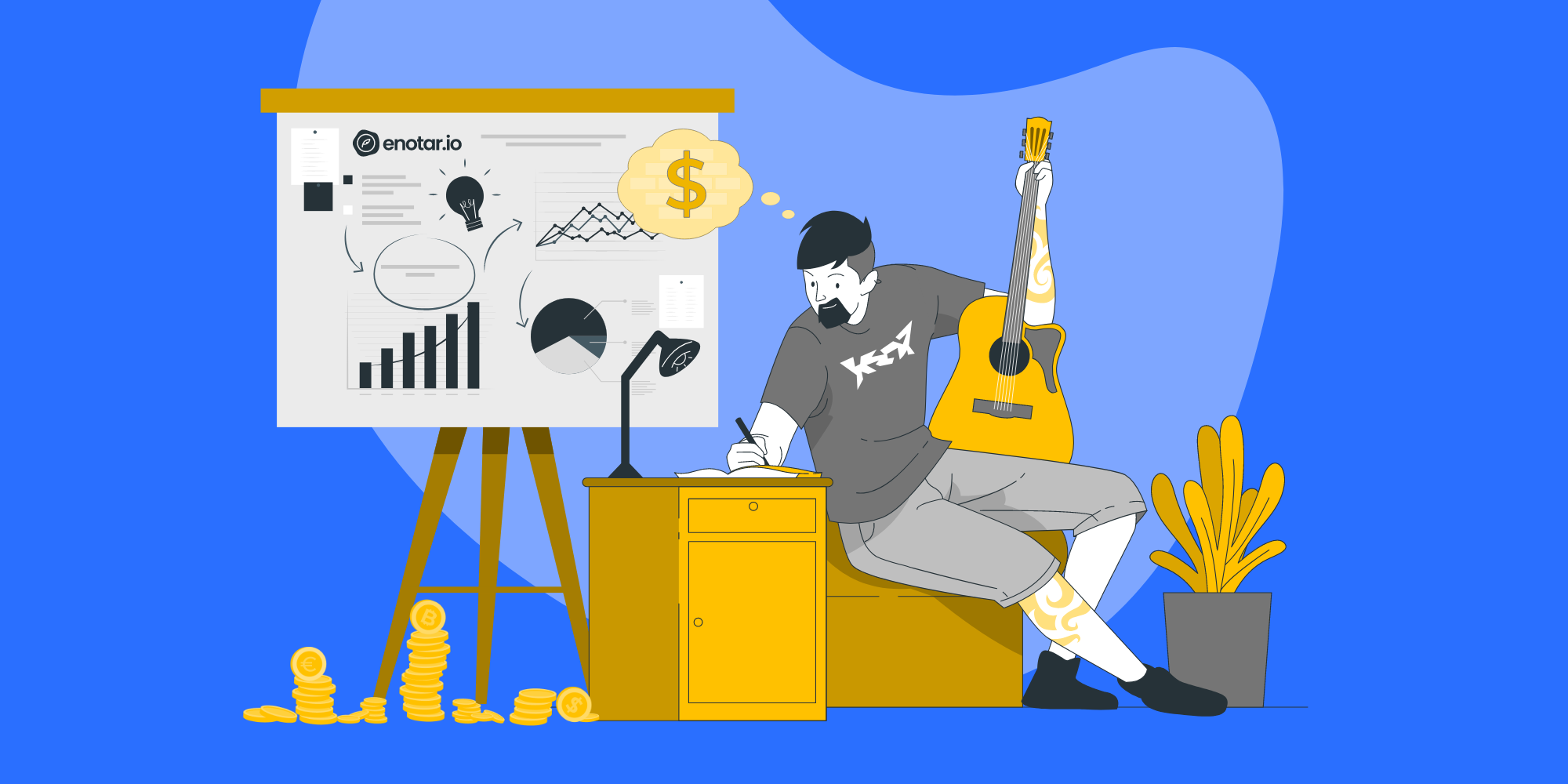If you are a musician, songwriter or producer, understanding the different types of royalties is essential to understanding how music is monetized and ensuring you receive fair compensation for your work. In this guide, we will explore the different types of music royalties, how they work, relevant concepts and new trends in this sector.
What is the difference between copyright and music royalties?
Copyright is the exclusive legal right held by a creator or owner over his or her original work. This right gives the creator control over the reproduction, distribution, exhibition, adaptation and public performance of his work. It is granted automatically once an original work is created and it is advisable to register it, since it provides documentary evidence of the existence and ownership of the work, as well as facilitates the legal protection and defense of this right.
On the other hand, royalties are payments or economic compensations made to copyright holders for the use or exploitation of their protected works. These works may include songs, sheet music, jingles, among others. Royalties are generated when someone uses, reproduces, distributes, publicly displays or performs any activity involving the use of a copyrighted work.
In short, copyright is the exclusive legal right that a creator has over his original work, granting him control and legal protection over the reproduction, distribution, exhibition and public performance of his work. Royalties are the form of economic compensation associated with the exercise of copyright. The registration of copyrights and the collection of royalties are managed by different entities.
1. Mechanical royalties
Mechanical royalties in the music industry are payments made to composers and copyright holders for the reproduction and distribution of their musical works in physical or digital formats. These royalties are financial compensation generated each time a copy of a song is manufactured or reproduced, whether in the form of CD, vinyl, digital download or online streaming.
When a song is recorded and released to the public, mechanical royalties are generated for the authors of the music and lyrics. These royalties are agreed upon through contracts and are usually set as a percentage of the retail price of the music product.
Tariff
In the physical format: for example, if a CD sells for $10 and the royalty agreement provides for 10%, songwriters will receive $1 for each unit sold. For streaming platforms, mechanical royalties are calculated differently. Instead of being based on a sales price, formulas based on the number of plays or revenue generated by the streaming service are used.
2. Synchronization Royalties
Synchronization royalties, also known as synchronization licenses, are payments made to musicians for the use of their music in combination with images in films, television programs, commercials, video games and other audiovisual media.
When music is used in an audiovisual production, whether as background music, main theme, song in a specific scene or any other use, it is required to obtain a synchronization license. This license allows the copyright holder to authorize the use of its music in combination with the visual content.
Tariff
Royalties are agreed upon through contracts between authors and audiovisual producers. The amount of royalties varies and is negotiated on a case-by-case basis, depending on factors such as the popularity of the song, the duration of use, the nature of the project and the available budget.
3. Public performance royalties
Public performance royalties are economic compensations made to composers and authors when their music is reproduced or performed in public places and media. These royalties are generated when a song is played in places such as bars, restaurants, stores, stadiums, as well as on radio and television stations.
When music is played in a public setting, it is considered a public performance and a license is required to do so. This license allows the copyright holder to authorize the reproduction of its music in places where the public can enjoy it.
Tariff
Public performance royalty rates are set according to various factors, such as the type of establishment or media, the size of the audience reached, the duration of the reproduction and the reach of the audience. These rates are agreed upon in negotiations between collecting societies and music users, such as owners of establishments or broadcasters.
4. Sampling royalties
Sampling royalties are generated when a portion of a previously recorded song is used in a new musical composition, since sampling involves taking a portion of an original recording and using it as an element in something new. These royalties are negotiated with the author of the original song.
When a sample is used in a new song, legal permissions must be obtained and the composers of the work may include the composer of the sampled song, the performers, record labels and others involved in the original recording.
Tariff
These types of royalties can be agreed upon in a variety of ways. In some cases, a fixed fee may be set for the use of the sample, while in other cases a percentage of the royalties generated by the new song is negotiated.
5. Non-Fungible Tokens (NFTs)
NFTs (Non-Fungible Tokens) are unique and indivisible digital representations of an asset or work. In the context of music, NFTs are used to represent and market musical works, such as songs, albums, remixes or any other musical content.
The way NFTs in music work is through blockchain technology. Each music NFT is created and registered on a blockchain and contains unique information that distinguishes it from any other NFT.
The monetization of NFTs in music is based on the sale and resale of these tokens on specialized platforms. Although the simple act of acquiring them is considered a form of storing value.
When a music NFT is sold, the buyer acquires ownership of the token. In addition, these tokens can offer additional features for buyers, such as exclusive content, access to events or unique music-related experiences. These incentives add value and attractiveness to music projects.
In the context of collecting, NFTs in music have gained popularity as a unique way to acquire and own digital musical works due to their exclusive nature, as each token represents a unique piece of music content.
Tokens can be limited in number this makes collectors perceive the NFT as a valuable and unique piece in their collection.
It is important to note that NFTs themselves do not automatically grant copyright to the musical work. Copyright and licenses for the use of the music must be considered and managed separately.
Tariff
The initial selling price is set by the token creator but if the musical NFT becomes more popular or if the associated artist gains more recognition, it is possible that the value of the NFT will increase in the marketplace, creating benefits for the token holders and the artist.
Collective Management Associations
Collective management associations function as intermediaries between rights holders (such as composers, authors, performers, producers) and users of protected works (such as radio broadcasters, television channels, online streaming services, commercial establishments and public events.).
They are responsible for negotiating agreements that allow users to use the musical, literary or audiovisual works of members registered with the organization in exchange for the payment of royalties. Their main purpose is to ensure that rights holders receive compensation for the use of their works and to facilitate the management and collection of royalties.
Some of the most relevant functions of these associations are:
Representation
Collective management associations represent right holders and negotiate on their behalf licensing agreements with users of protected works. These agreements establish the terms and conditions for the use of the works and the corresponding economic compensation (royalties).
Royalty collection
Collective management associations collect royalties generated by the use of protected works. This includes identifying and monitoring usage activities, issuing invoices and managing payments by users of the works.
Once royalties are collected, the organization deducts a portion to cover its administrative and operating expenses, and then distributes the remainder to copyright owners according to established agreements and the organization’s distribution policies.
Royalty distribution
After collecting royalties, collective management associations distribute payments to rights holders according to established agreements and policies. The distribution is based on criteria such as use of the works, popularity, time of reproduction and other agreed factors.
It is important to note that collective management organizations are entities authorized and regulated by the laws of each country. It should also be clear that when you register works with a collective management association you are not registering a copyright.
Final thoughts
Royalties are a fundamental part of the music industry’s compensation system. Understanding how royalties and music monetization mechanisms work will help you profit from your music creations and get compensated for your work. Be sure to work with collective management associations, register your copyrights and obtain proper permissions when using other artists’ music.
Music is valuable and deserves to be properly rewarded!
Illustration made with resources taken from Story Set.


